So many varieties of lime trees to choose from!
And they can be green or yellow, sweet or tart, depending on where you're from! All are either subtropical or tropical and are cold sensitive to varying degrees.
Limes are native to the Middle East and were first grown on a large scale in old Persia and southern Iraq. They have since been introduced all over the world and are grown commercially in CA & FL. Most lime trees should be protected from frost, though Persian Limes are the most cold tolerant.

Key Limes
Citrus aurantiifolia
aka "Mexican Lime"
Key Limes are a shrubby, thorny tree that can reach as much as 10-15 feet tall, is cold sensitive, but is more drought tolerant than most other citrus.
Key Limes are a small fruit, and pack a punchy flavor unlike any other lime varieties. This is the one that made key lime pies famous. Trees are propagated by seeds or grafts: grafting means it will bear fruit sooner.
Grown primarily in the US in FL, many commercial orchards were wiped out by a hurricane in 1926. Must protect trees from freezes: might acclimate to light freezes to 31 degrees, but otherwise protect from frost.
Plant on the south side of a building, where either the building or other evergreens shield the plant from wind damage. And feed your plants throughout the year with healthy soil amendments to boost the plant's immune system and resistance to weather extremes.
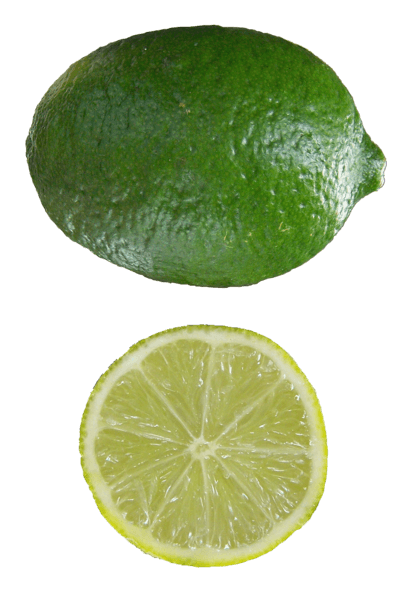
Key Limes: aka 'Mexican Lime'
photo credits: Wikipedia
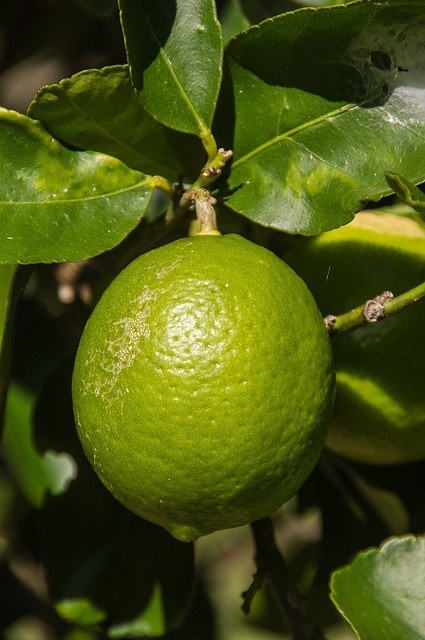
Persian Lime fruit hanging on the tree
Persian Limes
Citrus x latifolia
aka "Tahiti lime" or "Bearss lime"
The (American) Persian lime is the most commonly cultivated lime for commercial use in the US. It is a hybrid, most likely a cross between a key lime and either a lemon (Citrus x limon) or a citron (Citrus medica).
Persian lime is a larger, seedless variety developed by John Bearss in 1895 at his nursery in CA. The trees are nearly thornless as well, and can reach heights up to 15-20 feet. Most commonly propagated by grafting, but sometimes with air-layering.
It has less intense citrus aromatics than the Key lime, is less acidic, does not have the bitterness that lends to the key lime's unique flavor, and has a longer shelf life. The fruit is oval, about 2.75 inches long and up to 2.5 inches in diameter, but it will get even larger if left too long on the tree.
Persian lime trees are generally the most cold tolerant of all the varieties of limes. A well fed Persian lime tree is generally hardy to short spells of 21-22 degrees. Protect from extended hard freeze! Feed organic soil amendments throughout the year to improve cold hardiness.
Grown primarily in FL, many commercial orchards were wiped out by Hurricane Andrew in 1992. Many are now imported from Mexico.
Red Limes
Citrus x aurantiifolia
Red Limes are a cross between a Rangpur lime and either a kumquat or a mandarin. Expert sources differ in opinion as to the origin, and original records are apparently lost or never kept. As mature trees, they can tolerate freezes in zone 8a --- as low as 10-15 degrees!
Red limes are orange skinned, shaped and sized like a Persian lime, and a deep orange almost red on the inside. Fruit is very juicy and contains only a few seeds. Flavor is very much like a traditional lime: somewhat tart, flavorful, with little to no orange flavor but maybe a hint of tart kumquat flavor. Makes an excellent substitute for traditional limes in recipes.
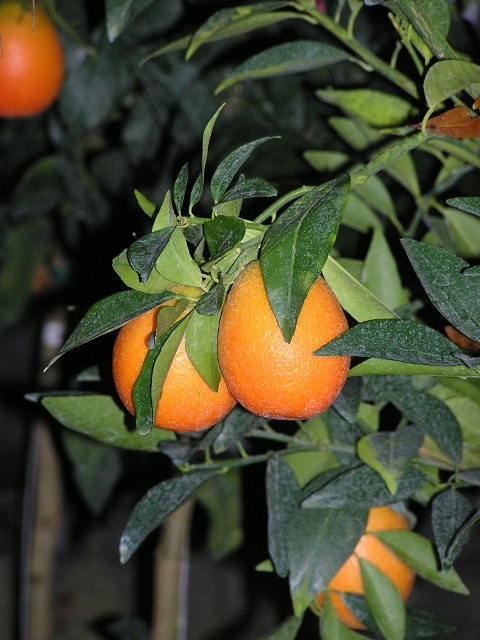
Red lime fruit is most attractive in the garden all summer long
Indian Sweet Limes
Citrus limettiodes Tan.
aka "Sweet lime" / "Palestine sweet lime" / "Mexican sweet lime"
aka "Persian sweet lime" in Brazil, but not the same as Persian Lime in America (Citrus x latifolia). Also called "Lima dulce" in Spanish.
It is not known how the sweet lime originated, but it is thought to be a hybrid between a Mexican-type lime and a sweet lemon.
Sweet lime fruits are small, round to slightly oblong, with a thin, smooth rind and prominent oil glands. When fully ripe, the rind is pale green to orange-yellow. Flesh is a pale yellow inside, tender and juicy w/ some seeds.
Fruit is very low acid (0.2% -- less than 1%), not tart, and hence is much sweeter than any of the other limes. Fruit can be eaten on its own or juiced. Often "juiced" right off the tree by sucking the juice out of a small hole cut in the top of the fruit.
Sweet lime blooms in the Winter and Spring and produces one crop per year. Trees are self pollinating, though cross-pollination with a sweet orange or grapefruit results in a greater harvest, larger fruit, and increased seeds. Must be kept from freezing temperatures.

In India where the fruit has been grown longer, many cultivars can be found -- not so in America. Often grown from cuttings in India.
In CA, there is much variance in the fruit depending on the growing conditions: desert-grown fruit is very different from fruit grown in cool, well irrigated coastal regions.
photo credits: Wikipedia
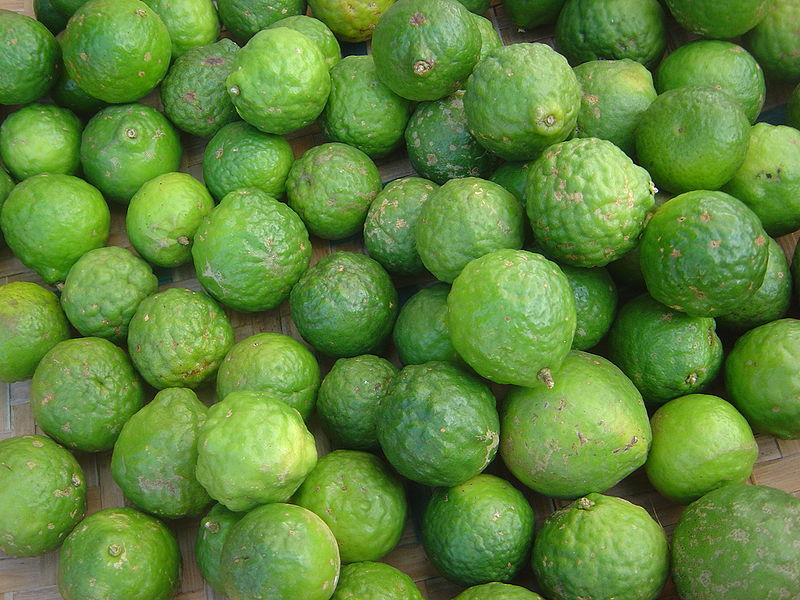
Kieffer Limes
Kieffer / Kaffir or Thai Limes
Citrus hystrix
The tropical Kaffir Lime is the most cold sensitive lime of all.
Kaffir Lime has a bumpy rind that contains high concentrations of aromatic oils, as do the leaves. Leaves and zest of the Thai lime is essential to Thai cuisine like Panang curry and lemongrass soup.
Commercially propagated by grafted, though it can be grown from cuttings or air-layering. It is sometimes used as a citrus rootstock.
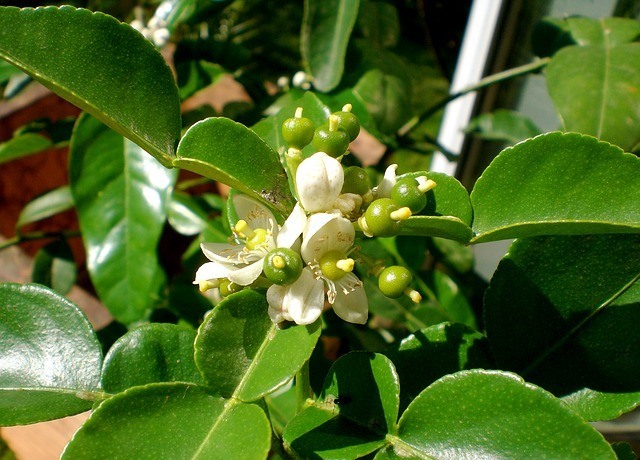
Kieffer Lime blossoms
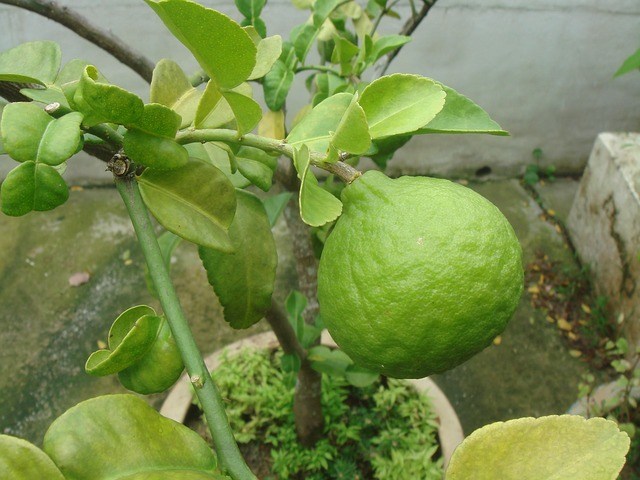
Kieffer Lime on a small tree
photo credits: Wikipedia
All lime trees on this page are available for special order subject to seasonal availability. They can be picked up at the nursery, or delivered via truck if you are within our delivery area. Contact us for details: we do not ship under any circumstances.
